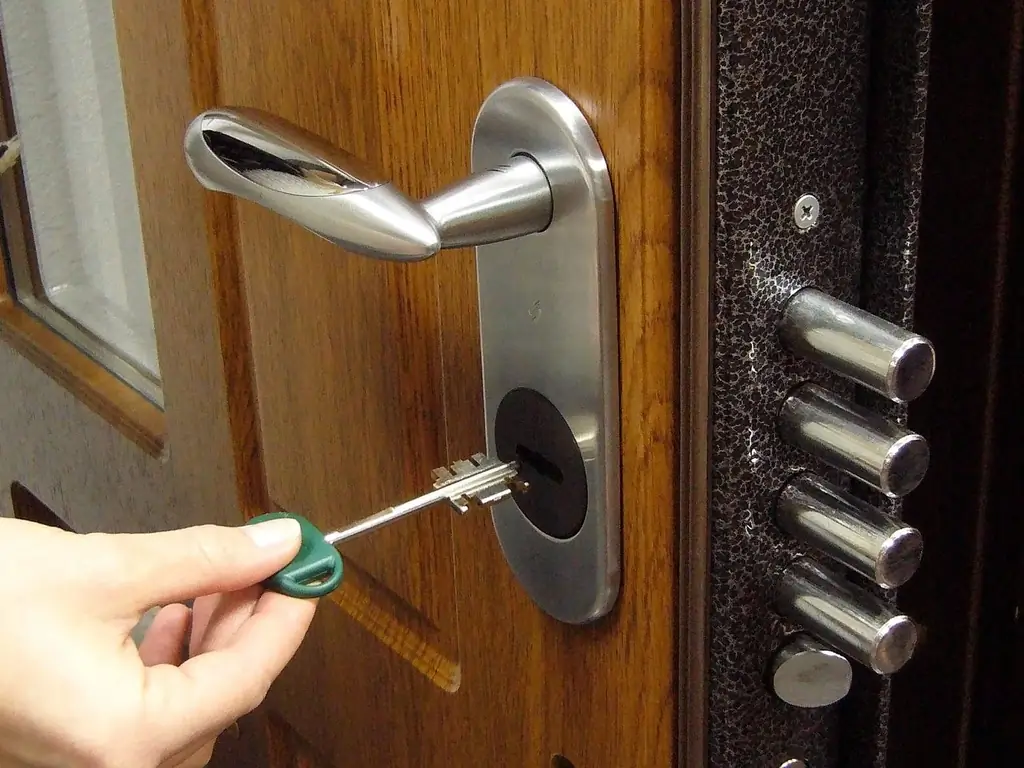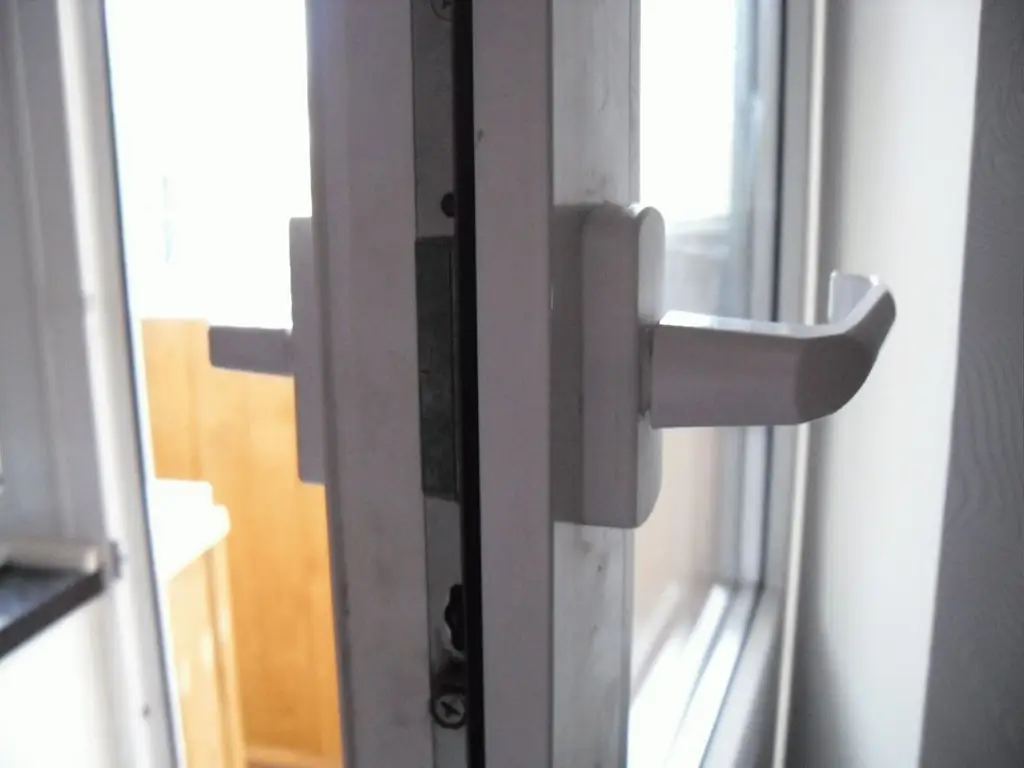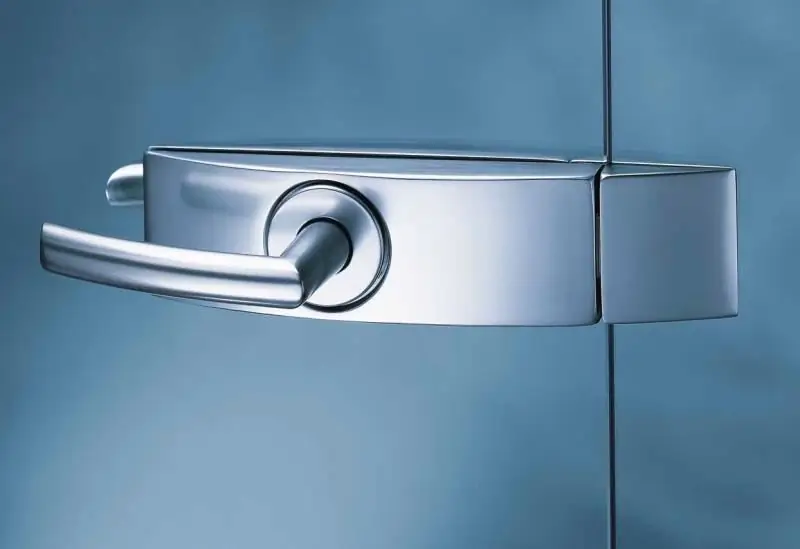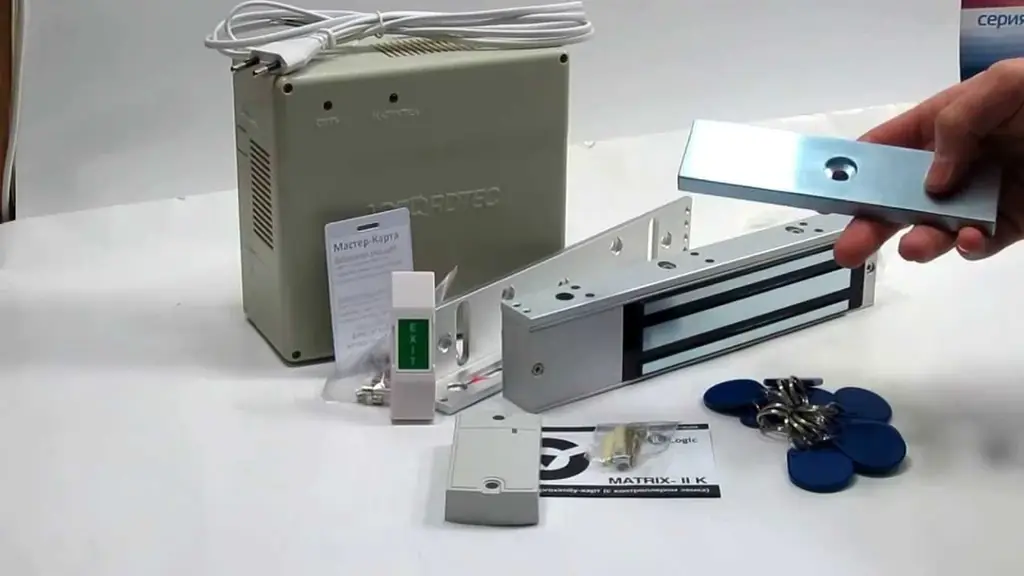
Table of contents:
- Author Bailey Albertson [email protected].
- Public 2023-12-17 12:53.
- Last modified 2025-06-01 07:32.
Types and characteristics of locks for an entrance metal door

If you are worried about the safety of your home, then when buying a metal front door, pay attention not only to the quality of the linen and accessories, but also to the locks installed in it. It depends on how reliable and high-quality the locks are, whether the front door can resist illegal entry into the house. In the modern construction market there is a large selection of door locks, so you can purchase one that will meet the requirements for safety, reliability and cost.
Content
-
1 Design features of locks for a metal door, their advantages and disadvantages
-
1.1 Lever locks
1.1.1 Video: the principle of operation of the lever lock
-
1.2 Cylinder structures
1.2.1 Video: the principle of the cylinder lock
-
-
2 Types of locks for a metal door
- 2.1 By working principle
- 2.2 By installation method
-
2.3 By class of resistance to burglary
2.3.1 Table: classification of locks by burglar resistance class
-
3 How to install the lock in a metal door yourself
-
3.1 Removing and replacing the lock
3.1.1 Video: dismantling the lock in a metal door and replacing it
- 3.2 Fitting a patch lock
-
3.3 Mounting the mortise lock
3.3.1 Video: installation of a mortise lock in a metal door
-
-
4 Repair of locks for metal doors
-
4.1 Major breakdowns and how to fix them
4.1.1 Video: Door Lock Repair
-
- 5 Operating tips
- 6 Reviews
Design features of locks for a metal door, their advantages and disadvantages
Since entrance metal doors must ensure the safety of the house, the internal structure of the locks used in them must be quite complex. When choosing, you need to focus on two main indicators:
- design;
- manufacturer.
According to the type of secret mechanism used, the locks are divided into two groups:
- levers;
- cylinder.
Lever locks
These are representatives of the mortise type of locks, they have been used for many years and have a relatively simple design. The principle of operation of such a mechanism is based on the coincidence of the plates (levers) located inside the lock, with the protrusions on the key. If all the projections and plates coincide, the lock opens, and if at least one projection does not match, it will not work to open the lock.
A feature of a lever lock is its simplicity of design, so it almost never fails, but it cannot provide high burglary resistance. In order to complicate the hacking process, models are created with a large number of levers - there can be from 2 to 12 pieces.

From 2 to 12 levers can be installed in the lever lock, their number and shape must match the configuration of the protrusions on the key
Do not think that it is very easy to open such a lock. This can be done with a master key, but only a high-class specialist can cope with such work, and there are very few of them, so you should not be very afraid of hacking.
If we talk about the advantages of a lever lock installed on the entrance metal doors, then the following should be noted:
- reliable protection against secretion drilling;
- ease of installation and maintenance;
- fairly high reliability;
- affordable cost.
This lock also has disadvantages:
- the key is large, in the area of the beard it is wide, especially if the maximum number of levers is set in the lock;
- there is a through well.
Video: the principle of operation of the lever lock
Cylinder structures
Cylinder locks are much better suited for a metal entrance door. These are more modern devices that appeared much later than the levers.
The advantages of cylinder mechanisms are:
- ease of use;
- ease of cylinder replacement and installation of more complex mechanisms;
- small keys.
If you have lost the key to such a lock, then you do not need to change the entire mechanism, it is enough to purchase a new cylinder with a set of keys. You can install it yourself, it will only take a few minutes.
The principle of operation of the cylinder lock is as follows: in the cylinder there are spring-loaded pins or, as they are also called, "pins". Each pin has two different lengths. After the key is inserted into the lock, all the pins are aligned with the teeth on the key and the lock can be opened. When using another key, the pins do not line up in one line, so it will not work to open the mechanism.

The more pins there are in the cylinder, the higher its reliability.
The more pins are installed in the cylinder, the more difficult it is to open such a mechanism. When purchasing a lock, you need to be interested in the number of pins and choose the one with the maximum number of them.
Among the disadvantages of the cylinder lock it should be noted:
- low resistance to burglary by drilling the cylinder - this disadvantage is compensated by the installation of armored linings;
- the ability to quite easily pull out the larva if installed incorrectly.
When choosing a core for entrance metal doors, one should pay attention not only to the type, but also to the material from which it is made. For entrance doors, you cannot purchase cupronickel locks; brass is the best option.

Brass larva is much stronger than cupronickel, but it costs more
Since the main task of entrance doors is to prevent illegal entry into the house, such a parameter as the degree of secrecy is of great importance for the castle. This indicator will depend on the following factors:
- the probability of coincidence with the keys from other locks;
- difficulties in picking a master key;
- reliability;
- service life.
According to the degree of reliability, locks for entrance doors are divided into the following categories:
- low level of secrecy. In such locks there is no protection against master keys, all the pins are in the center of the cylinder, the accuracy of their manufacture is low, and the number of combinations varies from 10 to 10,000;
- middle level. Here the number of possible combinations is already in the range of 5000-50,000, wear-resistant materials are used and the pins are offset from the center of the cylinder;
- high level of reliability. More than 100 thousand combinations are provided, there is a special protection against the use of master keys, high-quality materials are used.
Video: the principle of the cylinder lock
Varieties of locks for metal doors
Depending on the owner's requirements for the security of entrance metal doors, it is necessary to install different locks on them. Mechanisms differ from each other in several ways, which affect both the complexity and security of the lock, and its cost.
By the principle of work
Depending on the principle of operation, locks for metal entrance doors are:
-
mechanical. The door is locked by extending one or more crossbars. This is the most common solution that provides a high degree of security and is non-volatile;

Mechanical door lock Mechanical locks in entrance doors are the most common
-
electromagnetic. They work due to the presence of an electromagnet in their design and can be opened either with a code or from a card or key fob, and modern models are even controlled by a fingerprint. The main disadvantage of such devices is that in the absence of voltage in the network, they automatically open, so they must be provided with an autonomous power source, and this leads to additional costs;

Electromagnetic door lock In the absence of power supply, the electromagnetic lock automatically opens, therefore it is necessary to provide it with an autonomous power source
-
electromechanical. They combine the advantages of mechanical and electromagnetic devices. The door is locked with crossbars, but they are powered by electricity. Unlike an electromagnetic lock, for the operation of which it is necessary that electricity is constantly supplied to it, an electromechanical lock requires power only when the door is opened or closed.

Electromechanical door lock For the operation of the electromechanical lock, power is required only at the moment of opening / closing it, moreover, in the event of a power outage, it can be opened with an ordinary key
By installation method
There is a classification of locks according to the way they are installed:
-
waybills. Currently, they are practically not used on metal entrance doors, but are usually installed on wooden canvases so as not to violate their integrity. For them, they will be more reliable than mortise structures. Overhead models can be placed on homemade metal doors in porches, sheds or other utility rooms, when the canvas consists of only one sheet of metal;

Surface lock Most often, a patch lock is installed on wooden doors or metal doors in garages, sheds and other utility rooms.
-
mortise. They are the most common option for metal entrance doors. They are installed in a niche made at the end of the door leaf, to which they are attached using a special strip. The burglary resistance of such structures is high and largely depends on the quality of the core used;

Mortise lock Mortise locks are most often installed in metal entrance doors.
-
deposit. This is the newest type of door locks. Their difference from mortise is that they are inserted into a special pocket, which is made inside the door leaf, and only the crossbars protrude outward. This solution allows you to increase burglary resistance, but in order to repair or replace a failed lock, you will have to disassemble the entire door.

Insert lock If the inset lock breaks, you will have to disassemble the door leaf to repair it
Burglary resistance class
Burglary resistance class of a lock is characterized by such an indicator as the time spent on breaking it by means of mechanical or electrical impact.
There are 4 classes of burglary resistance:
- the first is characterized by low burglary resistance, so these locks are not suitable for entrance doors and are usually used inside the house;
- the second - five minutes are enough for breaking. If you decide to install such a lock at the entrance, then together with it you must either use an additional locking device, or mount it on one of the double doors, and install a more reliable device on the other;
- the third class is distinguished by increased security properties, so it will take thieves about ten minutes to break it. This option is most often used on metal entrance doors. In order to ensure higher security, experts recommend installing two such locks at the same time;
- the fourth class has maximum burglary resistance - a professional will spend about thirty minutes opening it. If you purchased a door with such a lock and additionally installed an alarm, then you can be sure about the property and values that are in your house or apartment.
Table: classification of locks by burglar resistance class
| Castle class | Security properties | Force applied to the elements of the lock during strength test, not less, N | Resistance to opening, not less, min | Application area | ||
| deadbolt and striker plate | Deadbolt mechanism | Front plate and body connection | ||||
| I | low | 2940 | 785 | 785 | - | for utility rooms and inside the house |
| II | normal | 2940 | 785 | 785 | 5 | for entrance doors to the apartment |
| III | elevated | 4900 | 1500 | 1960 | ten | for entrance doors to an apartment that contains significant values and / or is accepted under protection |
| IV | high | 6860 | 1960 | 4900 | thirty | for entrance doors to an apartment that contains significant values and / or is accepted under protection |
To ensure maximum safety of the apartment, experts recommend installing different types of locks at the same time, as well as using armored plates and reinforcing the canvas in the area of the lock installation
How to install a lock in a metal door yourself
If you have basic locksmith skills and the necessary tools, then you can install a lock on a metal door yourself. Please note that metal is highly durable, so you need to purchase or rent the appropriate tools:
- electric drill;
- core;
- measuring elements;
- screwdriver;
- grinder;
- file;
- extension cord;
- tap;
- fasteners;
-
pencil.

Required tools for installing the lock The tools necessary to install a lock on a metal door are usually available from those who are ready to do this work on their own.
Since power tools will be used in the work, safety precautions must be followed to avoid injury
The sequence of installing the lock will depend on its type, since mortise and overhead models are mounted in different ways. It also matters whether the castle is being installed in the place of the old one or it is necessary to prepare a new niche for it.
Dismantling and replacing the lock
Replacing a broken mortise lock is very simple. The work is done in the following order:
-
Removing the handle. If it is, then it is necessary to unscrew the locking screw and pull out the pin, and then remove the handle.

Removing the door lock handle Before dismantling the lock, you must first remove the handle
-
Dismantling the lock. First, unscrew the screw fixing the lock cylinder, which is located at the end of the web, and then remove the lock. After that, the screws securing the lock are unscrewed and pulled out of the door.

Removing the door lock First, dismantle the cylinder, and then take out the lock
- Installation of a new lock. Installing a new lock is carried out in reverse order.
Video: dismantling the lock in a metal door and replacing it
Before installing the lock, its moving parts can be lubricated with graphite; the internal mechanism does not need to be lubricated
Installation of a patch lock
The peculiarity of overhead models of locks is that they are mounted directly on the door leaf, so there is no need to cut it.
Installation is performed in the following order:
-
Markup. The lock is usually installed at a height of 80-100 cm. A lock is applied at the chosen place and the places for its fastening and for the key are marked.

Door leaf marking The lock is usually installed at a height of 80-100 cm
-
Creation of a key hole. To do this, use a drill of the appropriate size.

Creating a key hole When creating a hole for a key, a drill is used, the diameter of which depends on the type of lock
-
Fixing the lock. With the help of pins and bolts, the body is fixed and a cover plate is installed from the outside, covering the key hole.

Installation of the lock Padlock can be either welded or bolted
-
Installation of a striker. The location of its location must be chosen so that the crossbars and the lock tongue exactly fit into the holes available for them.

Installing a striker The strike plate must be fixed very precisely so that the lock closes without jamming and extraneous sounds
Installation of a mortise lock
Although the installation of a mortise lock takes more time, you can also do it yourself.
-
Markup. The markings are applied to the end of the door, while making a margin of 1-2 mm so that the lock can enter the recess freely.

Marking for mortise lock It is necessary to mark the place for the lock so that it normally enters the prepared hole
-
Site preparation. With the help of a grinder or by drilling, a slot of the appropriate size is made at the end of the door. Inaccuracies can be removed with a file.

Making a place for a castle With the help of a grinder, a place for a lock is made at the end of the canvas
-
Marking the attachment points of the lock and keyhole. A thread is cut in the mounting holes. Using a drill, a through hole is made to install the cylinder.

Marking for the lock mount Places for fastening the lock are marked on the canvas and a hole is made for mounting the cylinder
-
Installing the lock and cylinder. After the final fixing of all parts, check the smooth operation of the locking device.

Installing a mortise lock The lock is inserted into the door and securely fixed
-
Drill holes for crossbars. To do this, the crossbars are lubricated, for example, with toothpaste and the lock is turned. Traces will remain on the doorframe, which will indicate the position of future holes.

Crossbar holes Holes are made in the box using an electric drill for the crossbars
- They check the operation of the lock - if there is no friction and squeaks, then everything is done correctly.
Video: installation of a mortise lock in a metal door
Repair of locks for metal doors
The lock, like any other mechanisms, wears out over time, as a result of which it may break down.
The main reasons for broken locks in metal entrance doors:
- improper installation, usually this is due to a skewed mechanism, because of which it works hard and the key often breaks;
- poor quality of the lock;
- wear of parts.
There are options when you can restore the operation of the lock without disassembling it. If the lock installed in the metal door starts to jam, do not rush to disassemble it, first do the following:
-
use a flashlight to carefully examine the keyhole. Often, children or hooligans put foreign objects in it, or garbage simply accumulates there. Using a needle and tweezers, you need to clean the keyhole - this will be enough to restore the lock to work;

Inspection and cleaning of the keyhole If foreign objects or debris get into the keyhole, they are taken out with tweezers and a needle
- examine the key carefully. If it is damaged, then this may be the reason for poor opening of the lock. If so, the key must be thrown away, otherwise it may get stuck in the lock or break while inside the keyhole.
Major breakdowns and ways to eliminate them
Consider the main breakdowns of the lock in a metal door and how to fix them.
-
Key jam. If cleaning and lubrication did not help, then the larva must be replaced.

Larva lubrication If the grease of the larva does not help, the secret must be replaced
- When slammed, the tongue does not close. It is necessary to adjust the position of the striker or expand the hole in the box
- To open the door, you have to push hard on it. It is necessary to adjust the position of the lock and striker.
- The mechanism is jammed. It is necessary to determine the cause of the breakdown - it can be a larva, body or other element - and replace it.
If a cheap lever lock is broken, it is easier to buy a new one than to repair an old mechanism. For expensive models, you can replace the levers.
-
Remove the lock cover.

Removing the lock cover Unscrew the screws and remove the lock cover
-
Squeeze the levers springs and take them out one by one.

Dismantling the lever mechanism In turn, squeeze the springs of the lever and take them out
-
New levers are inserted.

Insert new levers Insert new levers in reverse order
-
Close the cover and tighten the fixing screws.

Assembling the lock case Close the lock cover and tighten the fixing screws
Repairing a cylinder lock usually involves replacing the cylinder. We considered how to do this when we described the process of dismantling the castle. When buying a new larva, it must correspond in shape and size to the lock, so it is better to take a broken cylinder to the store.
If you have an expensive lock of a high-class burglary resistance, then if it breaks, it is better not to risk it and entrust the repair to specialists
Video: door lock repair
Operating tips
In order for the lock to work reliably and for a long time, it must first be installed correctly, and then properly operated. The new lock has factory lubrication, but over time it is lost, which can negatively affect its operation.
Periodic lubrication of the lock will significantly extend its life. The crossbars should be extended as far as possible, applied liquid lubricant and the lock closed for 30-40 seconds. To lubricate them well, it is necessary to carry out 3-4 such procedures.

A special liquid agent is used to lubricate the lock
On average, the lock is designed for 10-15 thousand opening / closing cycles, which allows it to work without breakdowns for 5-7 years
Expert advice:
- you should not save on installing the door, since if the frame or canvas is skewed, no lock will work normally;
- during the installation of the lock, it must not be hit. If you are not sure of your skill, then it is best to entrust the installation to professionals;
- Do not close doors with extended crossbars, as they can bend;
- the key must be inserted into the well until it stops and do not apply great efforts to turn it;
- you should not buy cheap locks, since their service life is short and their reliability is low;
- when installing two locks on one door, it is better that they have different mechanisms.
Reviews
To ensure reliable protection of the house, it is necessary that not only a high-quality and reliable lock, but also powerful metal doors be installed. Remember that even the most expensive fourth class burglar-proof locks can be opened, therefore, to ensure the safety of your home, install additional alarm and video surveillance. Only in this case you can be sure that the house or apartment is reliably protected from the illegal entry of uninvited guests.
Recommended:
Locks For Plastic Doors: Which Are Better To Use And How To Install Correctly

The main types of locks for plastic doors. Rules and sequence of work for the installation and dismantling of such locks
Door Locks: Types And Their Characteristics, How To Choose And Install Correctly, As Well As A Rating For Reliability

Varieties of door locks. How to choose the most reliable device. Do-it-yourself door lock installation and repair. Operating tips
Door Handles For Interior Doors: Varieties And Characteristics, Pros And Cons, And How To Install Correctly

How to choose the right handles for interior doors. Features of the handle design. Installing handles on different types of doors and DIY repair
Locks For Glass Doors With A Description And Characteristics, Which Are Better To Use And How To Install Correctly

What locks to choose for glass doors. The most popular types of devices, their pros and cons. Features of installation, repair and dismantling of various models
Electromagnetic Lock For Doors: Varieties And Design Features, How To Choose And Install Correctly

Types of electromagnetic locks and how they work. Self-installation, repair and operating features of electromagnetic locks
